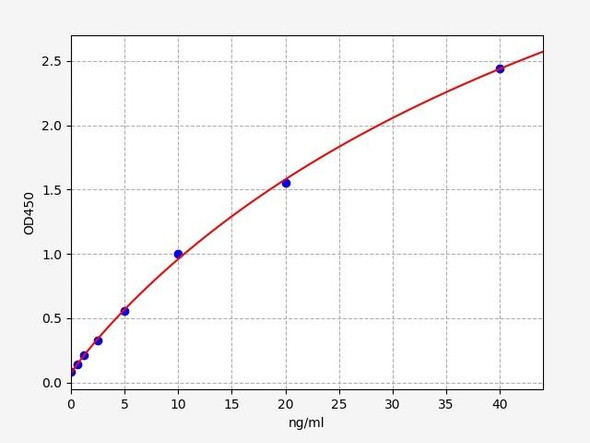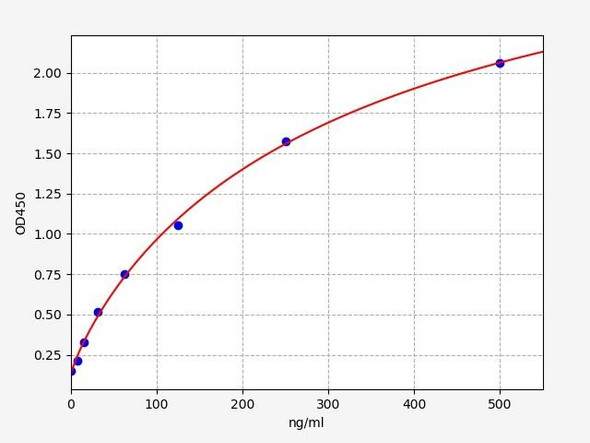Mouse TRF (Transferrin) ELISA Kit (MOES01577)
- SKU:
- MOES01577
- Product Type:
- ELISA Kit
- Size:
- 96 Assays
- Uniprot:
- Q921I1
- Sensitivity:
- 0.94ng/mL
- Range:
- 1.56-100ng/mL
- ELISA Type:
- Sandwich
- Synonyms:
- TF, PRO1557, PRO2086, TFQTL1, Siderophilin
- Reactivity:
- Mouse
- Sample Type:
- Serum, plasma and other biological fluids
- Research Area:
- Signal Transduction
Description
Mouse TRF (Transferrin) ELISA Kit
The Mouse TRF (Transferrin) ELISA Kit is specifically designed for the precise measurement of transferrin levels in mouse serum, plasma, and cell culture supernatants. This kit offers exceptional sensitivity and specificity, guaranteeing accurate and consistent results for various research purposes.Transferrin is a key protein involved in iron transport and homeostasis, crucial for various physiological processes such as oxygen transport and cell growth. Dysregulation of transferrin levels has been implicated in diseases like iron deficiency anemia and hemochromatosis, highlighting its importance as a biomarker in studying these conditions and developing potential therapeutic interventions.
With its reliability and performance, the Mouse TRF (Transferrin) ELISA Kit is an invaluable tool for researchers studying iron metabolism, iron-related disorders, and therapeutic strategies targeting transferrin levels. Get yours today to advance your research with confidence.
| Assay type: | Sandwich |
| Format: | 96T |
| Assay time: | 4.5h |
| Reactivity: | Mouse |
| Detection Method: | Colormetric |
| Detection Range: | 1.56-100 ng/mL |
| Sensitivity: | 0.94 ng/mL |
| Sample Volume Required Per Well: | 100µL |
| Sample Type: | Serum, plasma and other biological fluids |
| Specificity: | This kit recognizes Mouse TRF in samples. No significant cross-reactivity or interference between Mouse TRF and analogues was observed. |
This ELISA kit uses Sandwich-ELISA as the method. The micro ELISA plate provided in this kit has been pre-coated with an antibody specific to Mouse TRF. Standards or samples are added to the appropriate micro ELISA plate wells and combined with the specific antibody. Then a biotinylated detection antibody specific for Mouse TRF and Avidin-Horseradish Peroxidase (HRP) conjugate are added to each micro plate well successively and incubated. Free components are washed away. The substrate solution is added to each well. Only those wells that contain Mouse TRF, biotinylated detection antibody and Avidin-HRP conjugate will appear blue in color. The enzyme-substrate reaction is terminated by adding Stop Solution and the color turns yellow. The optical density (OD) is measured spectrophotometrically at a wavelength of 450 nm ± 2 nm. The OD value is proportional to the concentration of Mouse TRF. The concentration of Mouse TRF in samples can be calculated by comparing the OD of the samples to the standard curve.
| UniProt Protein Function: | TF: Transferrins are iron binding transport proteins which can bind two Fe(3+) ions in association with the binding of an anion, usually bicarbonate. It is responsible for the transport of iron from sites of absorption and heme degradation to those of storage and utilization. Serum transferrin may also have a further role in stimulating cell proliferation. Defects in TF are the cause of atransferrinemia (ATRAF). Atransferrinemia is rare autosomal recessive disorder characterized by iron overload and hypochromic anemia. Belongs to the transferrin family. |
| UniProt Protein Details: | Protein type:Secreted; Secreted, signal peptide Cellular Component: extracellular space; cell surface; cytoplasmic membrane-bound vesicle; early endosome; extracellular region; coated pit; recycling endosome; membrane; perinuclear region of cytoplasm; endocytic vesicle; apical plasma membrane; late endosome; basal plasma membrane; basement membrane; vesicle; endosome Molecular Function:protein binding; ferric iron binding; metal ion binding; ferric iron transmembrane transporter activity Biological Process: positive regulation of myelination; iron ion homeostasis; transport; positive regulation of transcription, DNA-dependent; actin filament organization; positive regulation of bone resorption; ion transport; osteoclast differentiation; ferric iron transport; iron ion transport; activation of JNK activity; positive regulation of phosphorylation |
| UniProt Code: | Q921I1 |
| NCBI GenInfo Identifier: | 20330802 |
| NCBI Gene ID: | 22041 |
| NCBI Accession: | NP_598738. 1 |
| UniProt Secondary Accession: | Q921I1,O35421, Q3UBW7, Q58E69, Q61803, Q62357, Q62358 Q62359, Q63915, Q64515, Q8VII5, Q922C0, |
| UniProt Related Accession: | Q921I1 |
| Molecular Weight: | 80. 0 kDa |
| NCBI Full Name: | serotransferrin |
| NCBI Synonym Full Names: | transferrin |
| NCBI Official Symbol: | Trf |
| NCBI Official Synonym Symbols: | HP; Tf; Tfn; hpx; Cd176; AI266983 |
| NCBI Protein Information: | serotransferrin |
| UniProt Protein Name: | Serotransferrin |
| UniProt Synonym Protein Names: | Beta-1 metal-binding globulin; Siderophilin |
| UniProt Gene Name: | Tf |
| UniProt Entry Name: | TRFE_MOUSE |
As the OD values of the standard curve may vary according to the conditions of the actual assay performance (e. g. operator, pipetting technique, washing technique or temperature effects), the operator should establish a standard curve for each test. Typical standard curve and data is provided below for reference only.
| Concentration (ng/mL) | O.D | Average | Corrected |
| 100 | 2.456 2.458 | 2.457 | 2.386 |
| 50 | 1.56 1.616 | 1.588 | 1.517 |
| 25 | 0.961 0.947 | 0.954 | 0.883 |
| 12.5 | 0.456 0.488 | 0.472 | 0.401 |
| 6.25 | 0.266 0.26 | 0.263 | 0.192 |
| 3.13 | 0.173 0.167 | 0.17 | 0.099 |
| 1.56 | 0.12 0.124 | 0.122 | 0.051 |
| 0 | 0.064 0.078 | 0.071 | -- |
Precision
Intra-assay Precision (Precision within an assay): 3 samples with low, mid range and high level Mouse TRF were tested 20 times on one plate, respectively.
Inter-assay Precision (Precision between assays): 3 samples with low, mid range and high level Mouse TRF were tested on 3 different plates, 20 replicates in each plate.
| Intra-assay Precision | Inter-assay Precision | |||||
| Sample | 1 | 2 | 3 | 1 | 2 | 3 |
| n | 20 | 20 | 20 | 20 | 20 | 20 |
| Mean (ng/mL) | 5.23 | 8.52 | 48.31 | 5.51 | 8.90 | 50.18 |
| Standard deviation | 0.36 | 0.36 | 1.97 | 0.35 | 0.46 | 2.32 |
| C V (%) | 6.88 | 4.23 | 4.08 | 6.35 | 5.17 | 4.62 |
Recovery
The recovery of Mouse TRF spiked at three different levels in samples throughout the range of the assay was evaluated in various matrices.
| Sample Type | Range (%) | Average Recovery (%) |
| Serum (n=5) | 96-108 | 101 |
| EDTA plasma (n=5) | 84-98 | 91 |
| Cell culture media (n=5) | 94-108 | 99 |
Linearity
Samples were spiked with high concentrations of Mouse TRF and diluted with Reference Standard & Sample Diluent to produce samples with values within the range of the assay.
| Serum (n=5) | EDTA plasma (n=5) | Cell culture media (n=5) | ||
| 1:2 | Range (%) | 91-106 | 93-110 | 93-106 |
| Average (%) | 97 | 100 | 99 | |
| 1:4 | Range (%) | 93-107 | 87-100 | 85-97 |
| Average (%) | 99 | 92 | 91 | |
| 1:8 | Range (%) | 91-108 | 85-101 | 82-93 |
| Average (%) | 99 | 92 | 88 | |
| 1:16 | Range (%) | 88-99 | 81-94 | 83-93 |
| Average (%) | 94 | 88 | 88 |
An unopened kit can be stored at 4°C for 1 month. If the kit is not used within 1 month, store the items separately according to the following conditions once the kit is received.
| Item | Specifications | Storage |
| Micro ELISA Plate(Dismountable) | 8 wells ×12 strips | -20°C, 6 months |
| Reference Standard | 2 vials | |
| Concentrated Biotinylated Detection Ab (100×) | 1 vial, 120 µL | |
| Concentrated HRP Conjugate (100×) | 1 vial, 120 µL | -20°C(shading light), 6 months |
| Reference Standard & Sample Diluent | 1 vial, 20 mL | 4°C, 6 months |
| Biotinylated Detection Ab Diluent | 1 vial, 14 mL | |
| HRP Conjugate Diluent | 1 vial, 14 mL | |
| Concentrated Wash Buffer (25×) | 1 vial, 30 mL | |
| Substrate Reagent | 1 vial, 10 mL | 4°C(shading light) |
| Stop Solution | 1 vial, 10 mL | 4°C |
| Plate Sealer | 5 pieces | |
| Product Description | 1 copy | |
| Certificate of Analysis | 1 copy |
- Set standard, test sample and control (zero) wells on the pre-coated plate and record theirpositions. It is recommended to measure each standard and sample in duplicate. Note: addall solutions to the bottom of the plate wells while avoiding contact with the well walls. Ensuresolutions do not foam when adding to the wells.
- Aliquot 100µl of standard solutions into the standard wells.
- Add 100µl of Sample / Standard dilution buffer into the control (zero) well.
- Add 100µl of properly diluted sample (serum, plasma, tissue homogenates and otherbiological fluids) into test sample wells.
- Cover the plate with the sealer provided in the kit and incubate for 90 min at 37°C.
- Aspirate the liquid from each well, do not wash. Immediately add 100µL of BiotinylatedDetection Ab working solution to each well. Cover the plate with a plate seal and gently mix. Incubate for 1 hour at 37°C.
- Aspirate or decant the solution from the plate and add 350µL of wash buffer to each welland incubate for 1-2 minutes at room temperature. Aspirate the solution from each well andclap the plate on absorbent filter paper to dry. Repeat this process 3 times. Note: a microplatewasher can be used in this step and other wash steps.
- Add 100µL of HRP Conjugate working solution to each well. Cover with a plate seal andincubate for 30 min at 37°C.
- Aspirate or decant the solution from each well. Repeat the wash process for five times asconducted in step 7.
- Add 90µL of Substrate Reagent to each well. Cover with a new plate seal and incubate forapproximately 15 min at 37°C. Protect the plate from light. Note: the reaction time can beshortened or extended according to the actual color change, but not by more than 30min.
- Add 50 µL of Stop Solution to each well. Note: Adding the stop solution should be done inthe same order as the substrate solution.
- Determine the optical density (OD value) of each well immediately with a microplate readerset at 450 nm.






